InterviewSolution
This section includes InterviewSolutions, each offering curated multiple-choice questions to sharpen your knowledge and support exam preparation. Choose a topic below to get started.
| 91501. |
(A): Adsorption is a surface phenomenon. (R) : During adsortion, residual force of surface decreases |
|
Answer» Both (A) and (R) are true and (R) is the CORRECT explanation of (A) |
|
| 91502. |
(A) Adsorption is a surface phenomenon.( R) Adsorption is an exothermic proces. |
|
Answer» Both (A) and (R ) are TRUE and (R ) is the CORRECT EXPLANATION of (A) |
|
| 91503. |
(A) Adenine pairs up with thymine but not with cytosine. (R) With cytosine, no hydrogen bonds are possible for adenine. |
|
Answer» Both A & R are true, R is the CORRECT EXPLANATION of A |
|
| 91504. |
A : Addition of HBr in buta-1, 3-diene gives 3 bromo-but-1-ene as major product at low Temperature. R : Addition of HBr in buta-1, 3-diene gives 1-bromo-but-2-ene as major product at high temperature. |
|
Answer» If both Assertion & REASON are TRUE and the reason is the correct explanation of the assertion, then MARK (1). |
|
| 91505. |
(A) Addition of water to (CH_3)_2 - C= CH - CH_3 gives (CH_3)_2 - COH - CH_2 - CH_3as major product(R) 3^@ carbocation is more stable than 2^@ carbocation |
|
Answer» Both (A) and (R) are TRUE and (R) is the CORRECT EXPLANATION of (A) |
|
| 91506. |
(A) Addition of C_2H_5OH to CH_3 MgI gives methane.(R) C_2H_5OH is more acidic than CH_4 |
|
Answer» Both (A) and (R) are TRUE and (R) is the correct EXPLANATION of (A) |
|
| 91507. |
(A) Addition of bromine to 2-butene yields 2,3-dibromobutane. (R) Bromine addition to an alkene in the presence of C CI_4 is an electrophilic addition. |
|
Answer» Both A & R are TRUE, R is the correct EXPLANATION of A |
|
| 91508. |
A : Addition of Br_(2) in trans-but-2-ene in the presence of CCI_(4) gives meso form. R : The reaction occurs through anti addition. |
|
Answer» If both Assertion & Reason are true and the reason is the correct explanation of the assertion, then MARK (1). |
|
| 91509. |
(A) Acrylic acid (CH_2 = CHCOOH) is a weaker acid than benzoic acid (C_6H_5COOH). (R) Electron withdrawing power of vinyl group is less than phenyl group. |
|
Answer» Both (A) and (R) are true and (R) is the CORRECT EXPLANATION of (A) |
|
| 91510. |
(A) Acidic nature increases from HOCl to HClO_(4) (R ) Oxidation number of chlorine increases from HClO to HClO_(4) |
|
Answer» Both (A) and (R ) are TRUE and (R ) is the correct explanation of (A) |
|
| 91511. |
(A) Acidic hydrolysis of ethyl acetate withexcess water is a first order reaction (R ) Concentration changes in water with time are negligibly small |
|
Answer» Both (A) and (R ) are true and (R ) is the correct EXPLANATION of (A) |
|
| 91512. |
a. Acid halides, anhydrides, esters and amides, all of them contain (C=O) group but none of them gives test for (C=O) group, i.e., they do not form oximes, hydrazones, and DNP derivatives, etc. Why? b. Arrange the following in the decreasing order of nucleophilic addition. i. (1) -CHO (2) -COCH_(3) (3) -COOH (4) -COCI (5) -CONH_(2) (6)-COOCH_(3) (7)-COO^(Θ) ii. (1) CH_(3)CHO (2) CH_(3)COCH_(3) (3) HCHO (4)CH_(2)H_(5)CH_(2)COCH_(3) iii. (1) CH_(3)COCH_(3) (2)C_(6)H_(5)COCH_(3) (3) C_(6)H_(5)COC_(6)H_(5) (4) C_(6)H_(5)CH_(2)COCH_(3) iv. (1)C_(6)H_(5)CHO (2) rho-CH_(3).C_(6)H_(4).CHO (3)rho-OH.C_(6)H_(4).CHO (4) rho-NO_(2).C_(6)H_(4).CHO (5) rho-CI.C_(6)H_(4).CHO v. (1) HCHO (2) CH_(3)CHO (3) CH_(3)COCH_(3) (4) CI_(3)C CHO c. Arrange the following in the increasing order of ease of hydrolysis. (1)C CH_(3)COOC_(2)H_(5) (2) CH_(3)COCI (3) (CH_(3)CO)_(2)O (4) CH_(3)CONH_(2) d. Arrange the following in the increasing order of ease of acid-catalysed esterification of: i. ii. (1) CH_(3)CH_(2)COOH (2) (CH_(3))_(2)CHCOOH (3) (CH_(3))_(3)C COOH iii. (1) CH_(3)CH_(2)CH_(2)OH (2) CH_(3)CHOHC_(2)H_(5) (3) (CH_(3))_(2)C(OH)C_(2)H_(5) e. Arrange the following esters in decresing order of ease of alkaline hydrolysis. i. (1) HCOOCH_(3) (2) CH_(3)COOCH_(3) (3) (CH_(3))_(3)C COOCH_(3) (4) (CH_(3))_(2)CHCOOCH_(3) ii. (1) CH_(3)COOCH_(3) (2) CH_(3)COOC(CH_(3))_(3) (3) CH_(3)COOCH(CH_(3))_(2) (4) CH_(3)COOCH_(2)CH_(3) iii. (1) C_(6)H_(5)COOCH_(3) (2) rho-CH_(3)O-C_(6)H_(4)-C COOCH_(3) (3) rho-NO_(2)-C_(6)H_(4)-COOCH_(3) (4) rho-Cl-C_(6)H_(4)-COOCH_(3) |
|
Answer» Solution :All the compounds do not contain a true `(C=O)` bond as shown by their resonance structures and hence do not give any test of `(C=O)` group. However, all the ACID derivatives react differently (nucleophilic acyl substitution) with ammonia derivatives e.g., I. REACTION of acid halide with ammonia derivative: i.  ii.  iii. 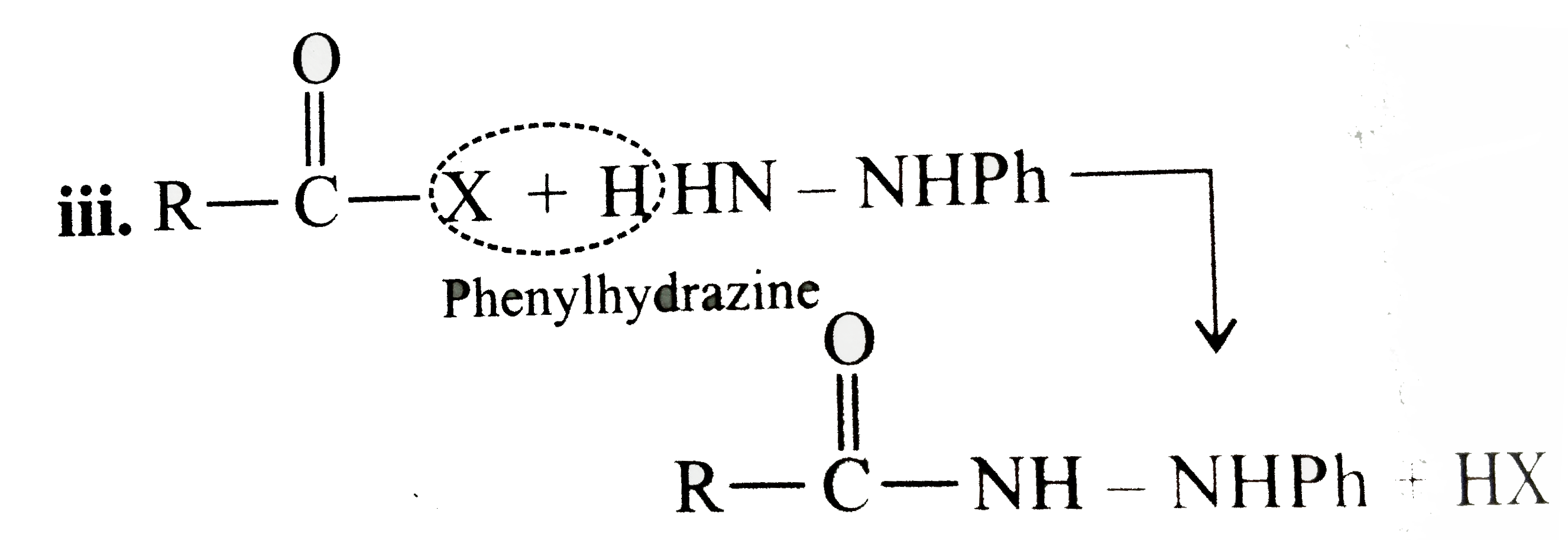 II. Reaction of anhydride with ammonia derivative: i. 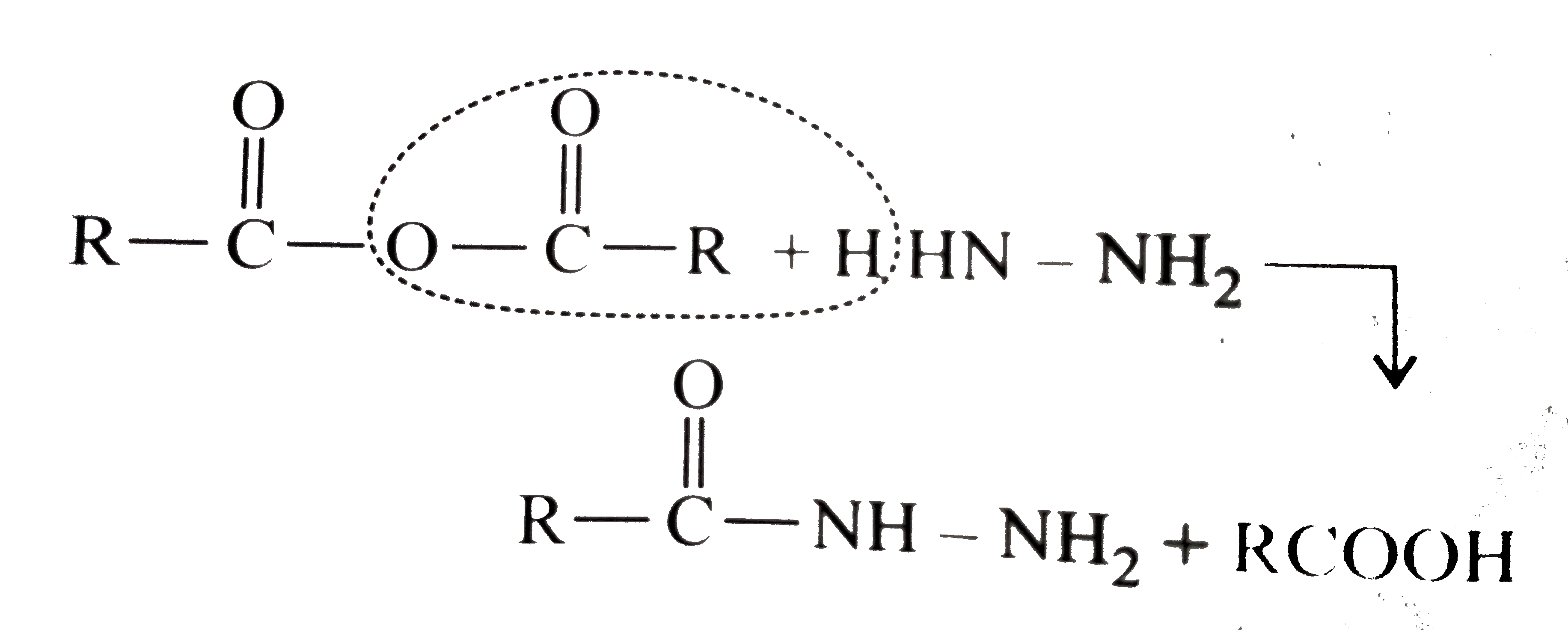 ii.  III. Reaction of esters with ammonia derivative: i. 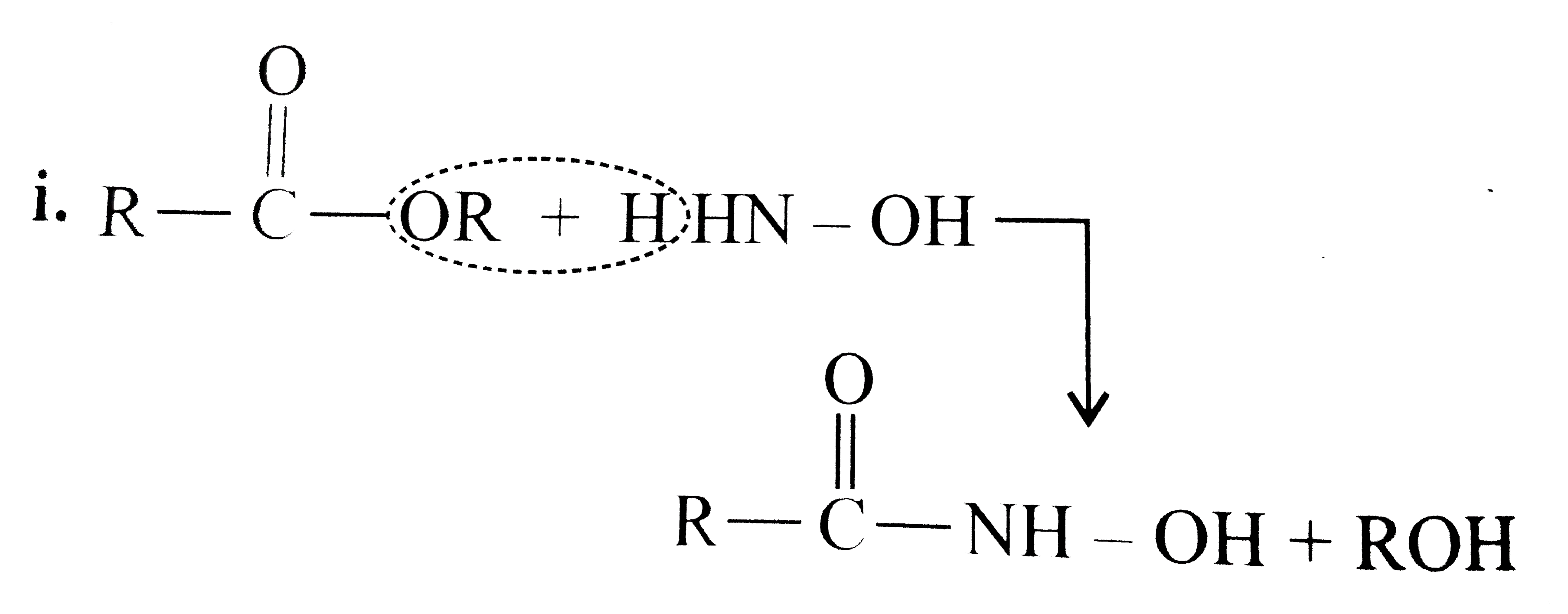 ii. 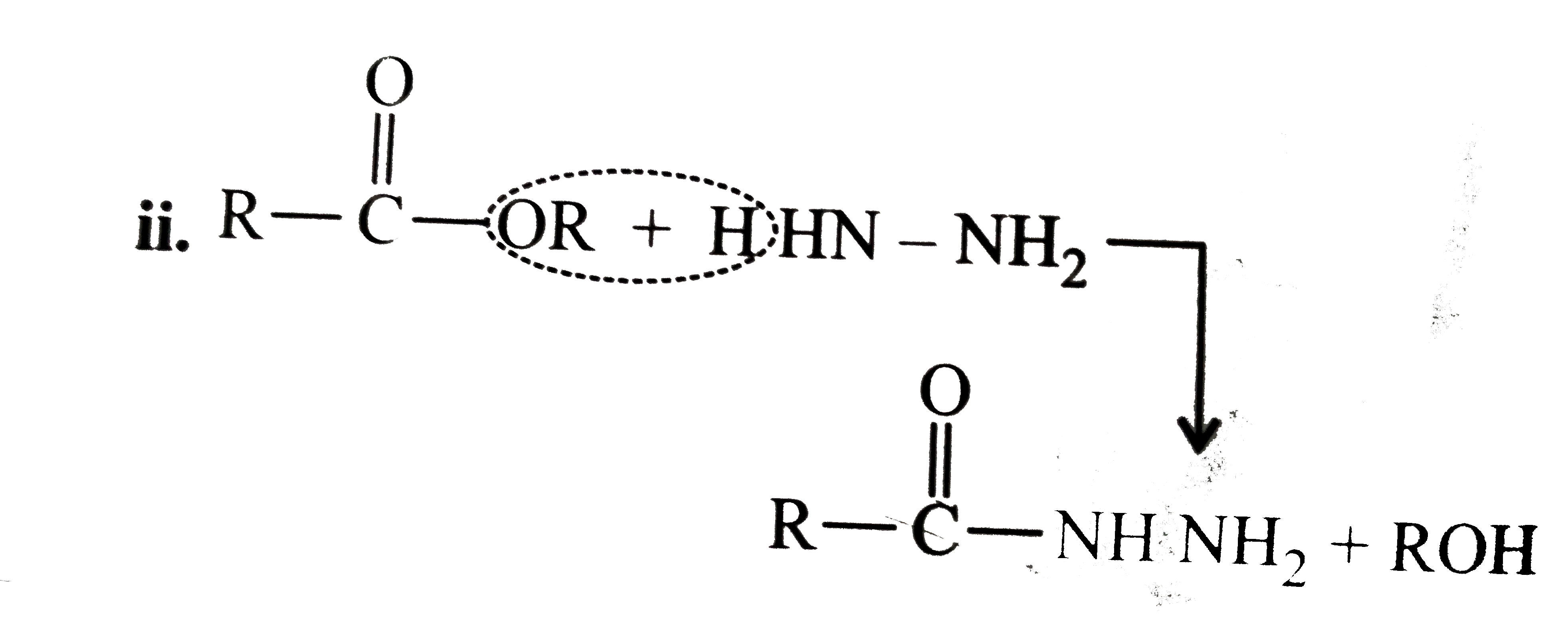 IV. Reaction of amide with ammonia derivative: i. 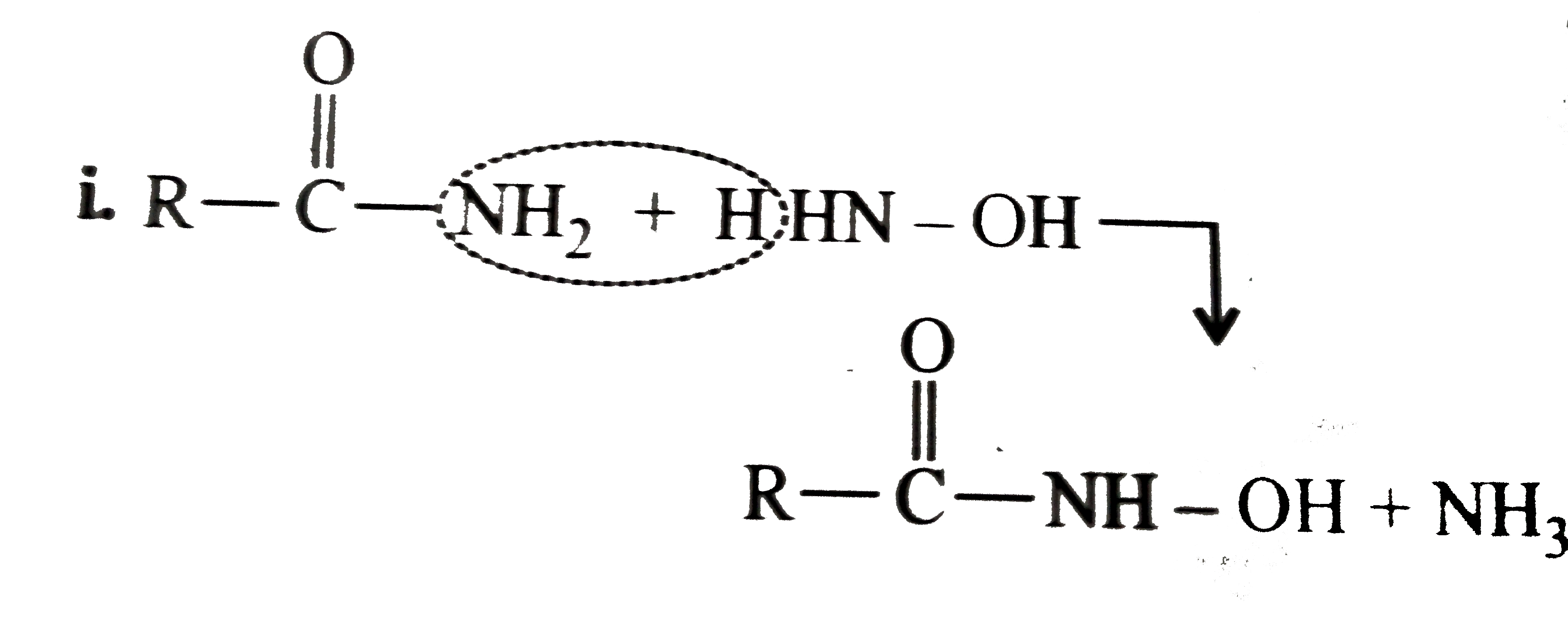 ii. 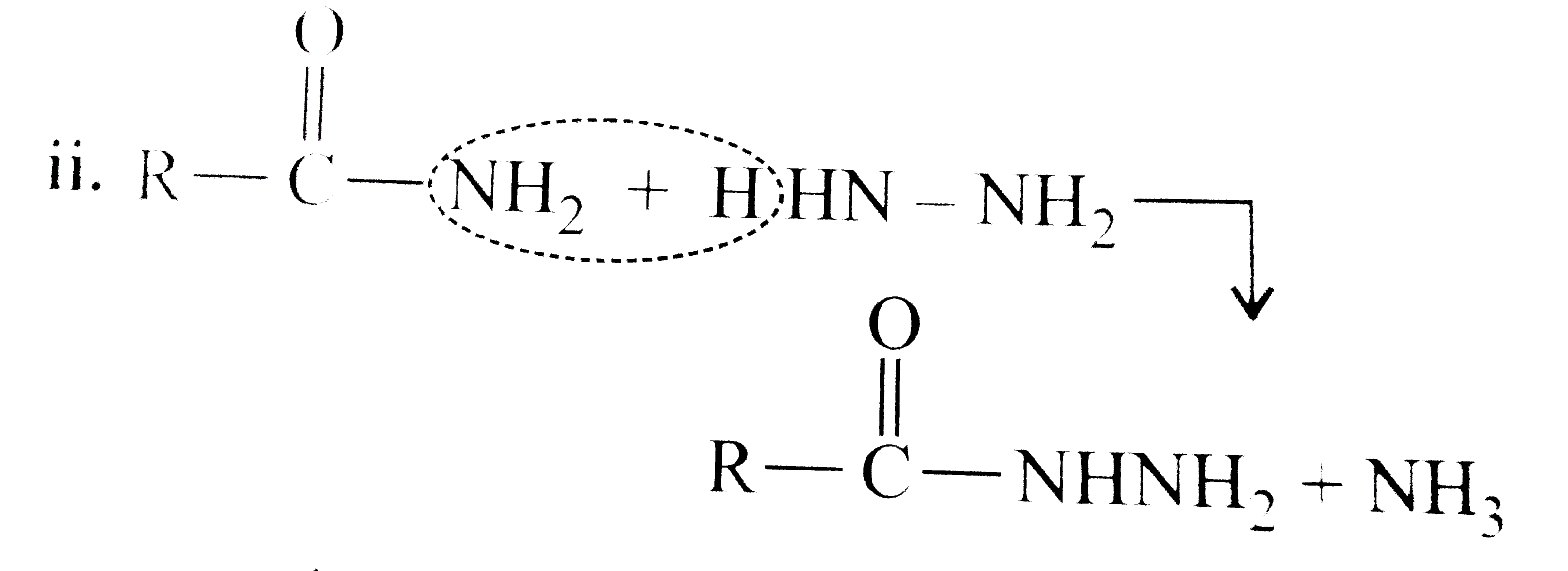 b. i. `1gt2gt4gt6gt5gt3gt7` (Aldehyde gt Ketone gt Acid chloride gt Ester gt Amidegt Acid gt Acid ion) ii. `3gt1gt2gt4` iii. `4gt1gt2gt3` More the `bar(e)-`withdrawing group, faster in the NA. In (4), Ph group is `bar(e)-`withdrawing by `-I` effect (+R cannot OCCUR, SINCE there is no extended conjugation)  iv. `4gt5gt1gt2gt3` `[rho-N NO_(2)-(-I and -R), rho-C1 (-I) gt "Standard" gt rho-Me (+I and H.C.) gt rho-OH (+R and -I)]` v. `4gt5gt1gt2gt3 [(C1_(3)C-CHO) (-I "of" 3C1)gtHCHOgtCH_(3)CHOgtCH_(3)COCH_(3)]` c. `2gt3gt1gt4` (Acid chloride gt Anhydride gt Ester gt Amide) d. As the size of substituents on the `alpha-`C increases, the tetrahedrally bonded intermediate becomes more crowded. Greater the crowding, slower is the reaction. i. `1gt2gt3` ii. `1gt2gt3` iii. `1gt2gt3` e. i. `1gt2gt4gt3` ii. `1gt4gt3gt2` iii. `3gt4gt1gt2` |
|
| 91513. |
(A) : Acetone gives yellow precipitate with iodine and alkali (R) :Acetone contains a methyl ketonic group . |
|
Answer» Both (A) and (R) are true and (R) is the CORRECT EXPLANATION of (A) |
|
| 91514. |
(A) Acetone gets oxidised by strong oxidising agents like Ag^(+),Cu^(+2) ,etc. (R)Oxidation of acetone involved carbon carbon bond cleavage. |
|
Answer» Both A & R are true, R is the CORRECT explanation of A |
|
| 91515. |
(a) Acetone boils at 56.38^@C and a solution of 1.41g of an organic compound in 20 g of acetone boils at 56.88^@C. Calculate the molar mass of the organic compound (Given K_(b) for acetone =1.67 K kg//mol). (b) What is reverse Osmosis?Mention one important application of it. |
|
Answer» Solution :(a) `AT_(b) = K_(b) XX`molality `AT_(b) = K_(b) xx (molality //( M solute)) xx 1000` / m solvent `(56.88 - 56.38) = 1.67 xx (L .41 // M solute) xx 100%` M solute = 235.47 (b) It is the process of movement of solvent molecules from higher concentration to low concentration by APPLYING pressure greater than osmotic pressure. APPLICATION : It is used in desalination of sea water. |
|
| 91516. |
(A) Acetone cannot be oxidised by weak oxidising agents like Ag^(+), Cu^(+2) etc. (R) Acetone is a weak reducing agent |
|
Answer» Both (A) and (R) are TRUE and (R) is the CORRECT EXPLANATION of (A) |
|
| 91517. |
(A) Acetone and propenol-2 are tautomers.(R) Propanone and propenol-2 contain different functional groups. |
|
Answer» Both (A) and (R) are true and (R) is the CORRECT EXPLANATION of (A) |
|
| 91518. |
(A) Acetic acid in vapour state shows a molecular mass of 120. (R) It undergoes intermolecular hydrogen bond & forms a dimer. |
|
Answer» Both (A) and (R) are TRUE and (R) is the CORRECT explanation of (A) |
|
| 91519. |
(A) Acetoacetic ester (CH_(3)-overset(O)overset(||)C-CH_(2)-overset(O)overset(||)C-OC_(2)H_(5)) will give iodoform test. (R) It contains methyl keto group |
|
Answer» If both (A) and ( R) are CORRECT and ( R) is the correct EXPLANATION of (A). |
|
| 91520. |
(A) Acetic acid does not give haloform reaction. (R) Acetic acid has no alpha-hydrogen. |
|
Answer» If both (A) and (R) are CORRECT and (R) is the correct EXPLANATION of (A). |
|
| 91521. |
(A) Acetic acid does not give haloform test. (R) Acetic acid has no alpha-hydrogen. |
|
Answer» Both (A) and (R) are TRUE and (R) is the CORRECT EXPLANATION of (A) |
|
| 91522. |
A: Aceteldehyde reacts with alkaline solution of sodium nitroprusside to give red colouration. R: Acetaldehyde is a good reducing agent. |
|
Answer» Both A and R are TRUE and R is CORRECT EXPLANATION of A |
|
| 91523. |
(A) :Acetaldehyde undergoes the aldol condensation with dil. NaOH. (R) : Acetaldehyde does not contain alpha -hydrogen |
|
Answer» Both A & R are true, R is the CORRECT explanation of A |
|
| 91524. |
(A) Acetate ion is less basic than methoxide ion.(R) Acetate ion is resonance stabilised while methoxide ion doesn't show resonance. |
|
Answer» Both (A) and (R) are true and (R) is the CORRECT explanation of (A) |
|
| 91525. |
(A) Acetaldehyde reduces Fehling's solution but acetone does not. (R) Acetaldehyde is stronger reducing agent than acetone. |
|
Answer» Both (A) and (R) are true and (R) is the CORRECT explanation of (A) |
|
| 91526. |
(A) : Acetaldehyde reduces Fehling's solution but benzaldehyde dose not. (R) : Acetaldehyde is a stronger reducing agent then benzaldehyde . |
|
Answer» Both A & R are true, R is the CORRECT EXPLANATION of A |
|
| 91527. |
(A) : Acetaldehyde reacts with HCN followed by acid catalysed hydrolysis gives optically active compound, lactic acid . (R) :In lactic acid molecule carbon is surrounded by four different groups and it is chiral molecule. |
|
Answer» Both A & R are true, R is the CORRECT explanation of A |
|
| 91528. |
(A): Acetaldehyde participates in aldol condensation reaction . (R) :Acetaldehyde contains alphahydrogen atom. |
|
Answer» Both A & R are TRUE, R is the correct explanation of A |
|
| 91529. |
(A) : Acetaldehyde forms hemiacetal with CH_(3) OHin the presence of dry HCI. (R): Hemiacetal contains both alcohol and alkoxy group. |
|
Answer» Both A & R are TRUE, R is the correct explanation of A |
|
| 91530. |
(a) Account for the following observations: (i) Hydrogen fluoride has higher boiling point than hydrogen chloride.(ii) Nitrogen is fairly inert gas. (b) Draw the molecular structure of peroxomonosulphuric acid. |
|
Answer» Solution :(a) (i) The boiling point of HF is higher than that of HCl. This is DUE to strong hydrogen bonding in HF because of larger electronegativity of fluorine. As a result of hydrogen bonding in HF, it exists as ASSOCIATED molecule, `(HF)_n` . Therefore, its boiling point is HIGH. `underset((HF)_n)(H-F.......H-F.......H-F..........H-F......)` However, in HCI, hydrogen bonding is negligible due to low electronegativity and large size of Cl atom. CONSEQUENTLY, its boiling point is low. (ii) In MOLECULAR nitrogen, there is a triple bond between two nitrogen atoms `(N -= N)`and it is nonpolar in character. Due to the presence of a triple bond, it has very high bond dissociation energy (945 kJ `"mol"^(-1)`) and, therefore, it does not react with other elements under normal conditions and is very unreactive. However it may react at higher temperature. (b) Molecular structure of peroxomonosulphuric acid `(H_2SO_3)`is : 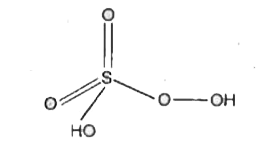
|
|
| 91531. |
(a) Account for the following, (i) Transition metals show variable oxidation states. (ii) Zn, Cd and Hg are soft metals. (c) E^(@) value for the Mn^(3+)//Mn^(2+) couple is highly positive (+1.57V) as compared to Cr^(3+)//Cr^(2+) (b) Write one similarity and one difference the chemistry of lanthanoid and actinoid elements. |
|
Answer» Solution :(a) (i) In the transition elements, the energies of (n-1)d orbitals and ns orbitals are very close. Hence, electrons from both can participate in bonding. (ii) Zn, Cd and Hg, all the `e^(-s)` in d-subshell are PAIRED. Hence, the metallic bonds are present in them are weak. That is why, they are soft metals and have low melting and boiling points. (iii) the large positive value of `E^(@)` for `Mn^(3+)//Mn^(2+)` shows that `Mn^(2+)` is much more STABLE than `Mn^(3+)` because `Mn^(2+)` has half-filled configuration WHEREAS, `E^(@)` value for `Cr^(3+)//Cr^(2+)` is negative because `Cr^(3+)` is more stable because of having stable half-filled `t_(2)g^(3)` configuration. (b) Similarity between lanthanoids and actinoids: Both show mainly an oxidation state of +3 and both are electopositive and very reactive. difference between Lanthanoids and actinoids: (i) Because +3, Lanthanoids show +2 and +4 oxidation state in few CASES, whereas, besides +3, actinoids show higher oxidation staets of +4,+5,+6++7 also. (ii) Lanthanoids have less tendency to form complexes whereas, actinoids have greater tendency to form complexes. |
|
| 91532. |
(a) Account for the following: (i) Transition metals show variable oxidation states. (ii) Zn, Cd and Hg are soft metals. (iii) E^(@) value for the Mn^(3+)//Mn^(2+) couple is highly positive (+1.57 V) as compared to Cr^(3+)//Cr^(2+). (b) Write one similarity and one difference between the chemistry of lanthanoid and actinoid elements. |
|
Answer» Solution :(a) (i) Transition metals show variable oxidation states. This happens because of incomplete filling of d-orbitals in such a way that their oxidation states differ by unity. (ii) The d-orbitals of Zn, CD and Hg are completely filled. There is no possibility of formation of BONDS between different atoms of the elements. Hence their melting points are low. In other words, they are soft metals. (iii) `Mn^(3+)//Mn^(2+)` couple has positive `E^(@)` value because change from `Mn^(3+)` to `Mn^(2+)` involves change of configuration to half-filled d which has extra stability. `Cr^(3+)//Cr^(2+)` couple has negative Eo value because `Cr^(3+)` has stable half-filled `(t_(2g))` configuration and `Cr^(2+)` has `d^(4)` configuration which is RELATIVELY unstable and hence negative `E^(@)` value. (B) See Question Number 2 above. |
|
| 91533. |
(a) Account for the following : (i) Transition metals form large number of complex compounds. (ii) The lowest oxide of transition metal is basic whereas the highest oxide is amphoteric or acidic. (iii) E^(@) value for the Mn^(3+)//Mn^(2+) couple is highly positive (+1.57 V) as compare to Cr^(3+)//Cr^(2+). (b) Write one similarity and one difference between the chemistry of lanthanoid and actinoid elements. |
|
Answer» Solution :(a) (i) Transition metals from a large number of complex compounds due to comparatively smaller sizes of metal ions, their high ionic charges and the availability of d-orbitals for bond formation. (ii) As we move from lowest oxide to the highest oxide, the lone pair of electrons on the metal decrease. Basicity of a substance depends upon the number of free electrons AVAILABLE for donation. THEREFORE lowest oxide of transition metal is BASIC and the highest oxide is amphoteric or acidic. (iii) `Mn^(3+)//Mn^(2+)` couple has positive `E^(@)` value because from `Mn^(3+)` to `Mn^(2+)` involves change of configuration to half-filled `d^(5)` which has extra stability. `Cr^(3+)//Cr^(2+)` couple has negative `E^(0)` value because `Cr^(3+)` has stable half-filled `(t_(2g))` configuration and `Cr^(2+)` has `d^(4)` configuration which is relatively unstable and hence negative `E^(@)` value. (b) Lanthanoid and ACTINOID elements Similarity - Both lanthanoid and actinoid involve filling of electrons in the inner shells. Both are inner transition elements. Difference - Ionisation enthalpies of earlier actinoids are LOWER than those of early lanthanoids. |
|
| 91534. |
(A) :Acetaldehyde and acetone can be distinguished by using 2,4 DNP. (R) : Acetaldehyde and acetone are both examples of carbonyl compounds. |
|
Answer» Both (A) and (R) are TRUE and (R) is the correct explanation of (A) |
|
| 91535. |
(a) Account for the following : (i) Tendency to show - 2 oxidation state decreases from oxygen to tellurium. (ii) Acidic character increases from HF to HI. (iii) Moist SO_2 gas acts as a reducing agent. (b) Draw the structure of an oxoacid of phosphorus containing P - 0 - P linkage. (c) Complete the following equation : XeF_(2) +H_(2) O to OR (a) Among the hydrides of group 16, write the hydride (i) which is a strong reducing agent ? (ii) which has maximum bond angle ? (iii) which is most thermally stable ? Give suitable reason in each. (b) Complete the following equations : AgNO_(3) +H_(2) O + H_(3) PO_(2) to (c ) CI_(2) + underset("(Cold and dilute)")NaOH to |
|
Answer» Solution :(a) (i) As we move from top to bottom in group 16, the metallic character increases. Thus Te behaves as a METAL. It has no tendency to gain the electrons. Thus, its tendency to show - 2 OXIDATION state decreases. (ii) Bond length between Hand the HALOGEN increases as we move from F to I. Thus, hydrogen is less strongly bonded to halogen and is available for reduction. (iii) It gets oxidised to sulphuric acid and therefore acts as a reducing AGENT. `SO_(2) + H_(2) O+ O to H_(2) SO_(4) +O` (b)  (c ) `2XeF_(2) + 2H_(2) O to 2Xe + 4 HF + O_(2) ` OR (a) (i) `H_2 Te` is the strongest reducing agent because the thermal stability is the MINIMUM. (ii) `H_2 O` has the maximum bond angle of 104.5°. As the size of group 16 element increases down the group, the electronegativity decreases. Group 16 element is not able to hold the lone pair of electrons to itself and lone pair-lone pair repulsions increase. Therefore `H_2 O` has the maximum angle and `H_2Te` the minimum angle. (iii) `H_(2) O` is thermally most stable because it has the maximum enthalpy of dissociation. (b) `Ag NO_(3) + H_(2) O+H_(3) PO_(2) to 4Ag + 4HNO_(3) +H_(3) PO_(4)` (c ) `CI_(2) + 2NaOH underset("dilute") overset("Cold and") (to) Na CI + Na CIO + H_(2) O` |
|
| 91536. |
(a) Account for the following (i) Ti^(3+) is coloured whereas Sc^(3+) is colourless in aqueous solution. (ii) Cr^(2+) is a strong reducing agent. (b) Write two similarities between chemistry of lanthanoids and actinoids. (c ) Complete the following ionic equation: 3MnO_4^(2-) +4H^+ to |
|
Answer» Solution :(i) `Sc^(3+)` has no electron in the d-orbitals. There is no possibility of EXCITATION to the electron from low energy d- orbital to high energy d-orbital. There is no absorption of radiation and hence no colour. `TI^(3+)` has one electron in 3d orbital. It adsorbs radiation in excitation from lower to higher d-orbital. It is therefore coloured. (ii) `Cr^(2+)` is a strong reducing agent. That means it easily oxidised to `Cr^(3+)` in which it has a configuration `3d^3`. It is a stable electronic configuration because it is half filled in the orbitals of `t_(2g)` which are three in number. (b) Similarities between the chemistry of lanthanoids and actinoids: (i) Variations in the magnetic susceptibilities of actinoids with the number of unpaired f electrons is ROUGHLY parallel to teh corresponding results for lanthanoids. (ii) The lanthanoid and actinoid contractions have extended effects on SIZES and PROPERTIES of elements succeeding them. (c ) `3MnO_4^(2-)+4H^(+) to 2MnO_4^(-)+MnO_2+2H_2O` |
|
| 91537. |
(a) Account for the following: (i) Ozone is thermodynamically unstable. (ii) Solid PCl_(5) is ionic in nature. (iii) Fluorine forms only one oxoacid HOF. (b) Draw the structure of (i) BrF_(5) (ii) XeF_(4) (i) Compare the oxidizing action of F_(2) and Cl_(2) by considering parameters such as bond dissociation enthalpy, electron gain enthalpy and hydration enthalpy. (ii) Write the conditions to maximize the yield of H_(2)SO_(4) by contact process. (iii) Arrange the following in the increasing order of property mentioned : (a) H_(3)PO_(3), H_(3)PO_(4), H_(3)PO_(2) (Reducing character) (b) NH_(3), PH_(3)m AsH_(3), SbH_(3), BiH_(3) (Base strength) |
|
Answer» Solution :(a) (i) Endothermic compound/decomposition of ozone is exothermic is nature and `DeltaG` is negative/decomposition of ozone is spontaneous. (ii) Exists as `[PCl_(4)]^(+)[PCl_(6)]^(+)` (III) Shows only-1 oxidation state/most electronegative element/ absence of d-orbitals (B)(i) 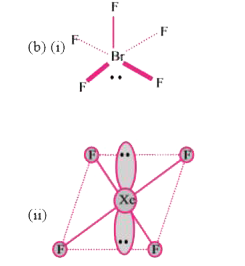 Or (i) `F_(2)` is the STRONGER oxidising agent than chlorine (a) low enthalpy of dissociation of `F-F` bond (b) less negative electron gain enthalpy of F high hydration enthalpyof `F^(+)` ion (ii) Low temperature, high pressure and presence of catalyst (ii) `H_(3)PO_(4)lt H_(3)PO_(3) lt H_(3)PO_(2)` (iii) `BiH_(3) lt SbH_(3) lt AsH_(3) lt PH_(3) lt NH_(3)` |
|
| 91538. |
(a) Account for the following : (i) Oxidising power in the series VO^(2+)ltCr_(2)O_(7)^(2-)lt MnO_(4)^(-). (ii) Actinoid contraction is greater from element to element than lanthanoid contraction. (iii) Oxoanions of a metal show higher oxidation state. (b) What is Misch metal ? Give its one use. |
|
Answer» Solution :(a) (i) The oxidising power of the species varies in the ORDER : `VO^(2+)lt Cr_(2)O_(7)^(2-)lt MnO_(4)^(-)` This is explained on the basis of increasing stability of the LOWER species to which they are reduced. (ii) Actinoid contraction is greater from element to element than lanthanoid contraction dueto POOR shielding of 5f electrons compared to that of 4f electrons in lanthanoids. (iii) Oxoanions of a metal shows higher oxidation state due to the ability of oxygen to form multiple bonds and its HIGH electronegativity. (b) Misch metal is an alloy 95% of a lanthanoid metal and 5% iron with traces of S, C, Ca and Al. Use: To PRODUCE bullets, shell and lighter flint. |
|
| 91539. |
(a) Account for the following : (i) Mn shows the highest oxidation state of +7 with oxygen but with fluorine it shows the highest oxidation state of +4. (ii) Cr^(2+) is a strong reducing agent. (iii) Cu^(2+) salts are coloured while Zn^(2+) salts are white. (b) Complete the following equations : (i) 2MnO_(2)+4KOH+O_(2)overset(Delta)to (ii) Cr_(2)O_(7)^(2-)+14H^(+)+6I^(-)to |
|
Answer» Solution :(a) (i) Mn can form double bonds with oxygen atoms and SHOWS an oxidation state of +7. FLUORINE is monovalent, only single bonds can be formed with fluorine and therefore the highest oxidation state shown by Mn with fluorine is +4. (ii) `Cr^(2+)` is a strong reducing agent. `Cr^(2+)` has the electronic configuration `d^(4)`. When it acts as a reducing agent, it is itself oxidised and changes to `Cr^(3+)`. The d-orbital configuration becomes `d^(3)`. It has stable half-filled `t_(2g)` configuration. (iii) The colour of transition metal IONS are due to d-d transitions of electrons i.e., from lower d-levels to higher d-levels `(t_(2g)" to "e_(G))`. `Cu^(2+)` ions contain an unpaired electron which on d-d transition gives blue colour. `Zn^(2+)` ions have no unpaired electron. There is no possibility of transition of electrons hence no colour. (B) (i) `2MnO_(2)+4KOH+O_(2)to2K_(2)MnO_(4)+2H_(2)O` (ii) `Cr_(2)O_(7)^(2-)+14H^(+)+6I^(-)to2Cr^(3+)+7H_(2)O+3I_(2)` |
|
| 91540. |
(a) Account for the following : (i) Hydration enthalpy of F^(-) ion is more than Cl^(-) ion. (ii) SO_(2) is a reducing agent, whereas TeO_(2) is an oxidising agent in group-16 oxides. (b) Write the reaction of F_(2) with water. Why does I_(2) not react with water ? (c) Draw the structure of XeF_(2). |
|
Answer» SOLUTION :(a) (i) Due to small size to F, the density of the NEGATIVE charge is greater on `F^(-)` than on `Cl^(-)`. Therefore HYDRATION enthalpy of `F^(-)` ion is more than that of `Cl^(-)`. (ii) `SO_(2)` is a reducing agent because S has d-orbitals and can expand its oxidation state from +4 to +6 and thus behave as a reducing agent. Heavier elements like Te do not expand the oxidation state from +4 to +6 due to inert PAIR effect. It acts as an oxidising agent. (b) `2F_(2)(g)+2H_(2)O(l)to4H^(+)(aq)+4F^(-)(aq)+O_(2)(g)` `I_(2)` does not react with water due to lower value of reduction potential (0.54 V). (c) Structure of `XeF_(2)` 
|
|
| 91541. |
(a) Account for the following: (i) Cu^(+) is unstable in an aqueous solution. (ii) Transition metals form complex compounds. (b) Complete the following equation: Cr_(2)O_(7)^(2-)+8H^(+)+3NO_(2)^(-)to |
|
Answer» Solution :(a) (i) `Cu^(+)` is unstable in an aqueous solution. It changes to `Cu^(2+)`. This is due to much more negative `Delta_(hyd)H^(@)` of `Cu^(2+)` than `Cu^(+)`, which more than compensates the second ionisation enthalpy of Cu. (ii) Transition metals FORM complex compounds due to comparatively SMALLER sizes of the metal ions, high ionic charges and the AVAILABILITY of d-orbitals for bond formation. (b) `Cr_(2)O_(7)^(2-)+14H^(+)+6e^(-)to2Cr^(3+)+7H_(2)O` `(3NO_(2)^(-)+3H_(2)O to3NO_(3)^(-)+6H^(+)+6e^(-))/(Cr^(2)O_(7)^(2-)+8H^(+)+3NO_(2)^(-)to2Cr^(3+)+3NO_(3)^(-)+4H_(2)O)` |
|
| 91542. |
(a) Account for the following : (i) Cu^(+) is unstable in an aqueous solution. (ii) Transition metals form complex compounds. (b) Complete the following equation: Cr_(2)O_(7)^(2-)+8H^(+)+3NO_(2)^(-)rarr |
|
Answer» SOLUTION :(ii) Becuase of smaller size of their METAL ions. Their high ionic charges. Vacand d-orbital so that these orbitals can accept lone pairs of e-donated byligonads and form coordinate bond. (B) `Cr_(2)O_(7)^(2-)+8H^(+)+3NO_(2)^(-)rarr3NO_(3)^(-)+2Cr_(3)^(+)+4H_(2)O` |
|
| 91543. |
(a) Account for the following: (i) Copper (I) compounds are white whereas Copper (II) compounds are coloured. (ii) Chromates change their colour when kept in an acidic solution. (iii) Zn, Cd, Hg are considered as d-block elements but not as transition elements. (b) Calculate the spin only moment of Co^(2+)(Z=27) by writing the electronic configuration of Co and Co^(2+). |
|
Answer» Solution :(a) (i) ELECTRONIC configurationof `Cu^(+)` is …. `3d^(10)`. The d-subshells are completely filled. No transition of electrons takes place between the d-orbitals. Hence, no colour. (ii) When CHROMATES are kept in an ACIDIC solution, it changes into dichromate. While chromates are yellow in colour, dichromates are ORANGE. `underset("Yellow")(2Na_(2)CrO_(4))+2H^(+) to underset("Orange")(Na_(2)Cr_(2)O_(7))+2Na^(+)+H_(2)O` (iii) Zn, Cd and Hg have completed d-orbitals in the outer shells. They don.t fit into the definition of transition elements which have incomplete d-orbitals of the inner shell. However, for the sake of convenience, they are placed in d-block elements. (b) Electronic configuration of `Co=3d^(7)4s^(2)` Electronic configuration of `Co^(2+)=3d^(7)` Number of unpaired electrons = 3 `mu=sqrt(3(3+2))=sqrt(3xx5)` `=sqrt(15)=3.87` |
|
| 91544. |
(a) Account for the following: (i) Ce^(4+) is a strong oxidising agent in aqueous solution. (ii) Transition metals have high enthalpy of atomisation. (iii) Mn shows maximum number of oxidation states in 3d series. (b) Complete the following equations: (i) 2MnO_(4)^(-)+6H^(+)+5NO_(2)^(-)to (ii) Cr_(2)O_(7)^(2-)+14H^(+)+6Fe^(2+)to |
|
Answer» Solution :(a) (i) In aqueous solutions `Ce^(4+)` tends to CHANGE to `Ce^(3+)` as +3 oxidation state is more stable. Therefore `Ce^(4+)` acts as an oxidising agent. (ii) Transition metals have a large number of UNPAIRED electrons in their atoms. They form strong metallic bonds and therefore have a high enthalpy of atomisation. (iii) Mn has the electronic configuration `-3d^(5)4s^(2)`. It shows oxidation states from +2 to +7. It has the maximum number of unpaired electrons. (b) (i) `MnO_(4)^(-)+8H^(+)+5e^(-)to Mn^(2+)+4H_(2)O"]"xx2` `(NO_(2)^(-)+H_(2)O to NO_(3)^(-)+2H^(+)+2e^(-)"]"xx5)/(2MnO_(4)^(-)+5NO_(2)^(-)+6H^(+)to 2Mn^(+)+5NO_(3)^(-)+3H_(2)O)` (ii) `Cr_(2)O_(7)^(2-)+14H^(+)+6e^(-)to 2Cr^(3+)+7H_(2)O` `(FE^(2+)toFe^(3+)+E^(-)"]"xx6)/(Cr_(2)O_(7)^(2-)+6Fe^(2+)+14H^(+)to 2Cr^(3+)+6Fe^(3+)+7H_(2)O)` |
|
| 91545. |
(a) Account for the following :(i) Acidic character increases from H_(2)O to H_(2)Te. (ii) F_(2)is more reactive than ClF_(3) , whereas ClF_(3)is more reactive thanCl_(2). (b) Draw the structure of (i) XeF_(2), (ii) XeOF_(4)(c) Give one example to show the anomalous reaction of fluorine. |
|
Answer» Solution :(a) (i) DUE to DECREASE in bond dissociation enthalpy of E-H (ii) Due to lower bond dissociation enthalpy of F-F bond than Cl-F bond whereas Cl–Cl bond has HIGHER bond dissociation enthalpy than Cl-F bond. 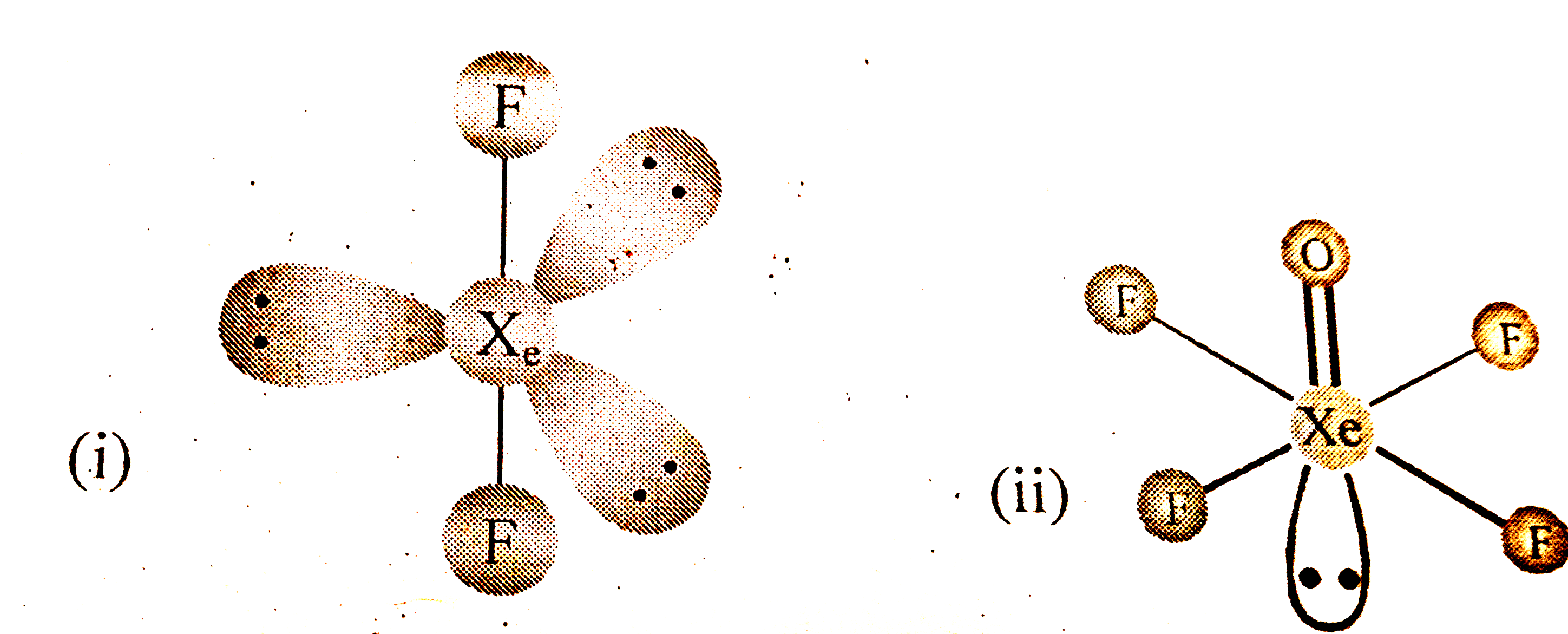 (c) `2F_(2)(G) + 2H_(2)O(l) rarr4H^(+)(aq) + 4F^(–)(aq) + O_(2)(g)` |
|
| 91546. |
(A): ABAB ..... pattern of close packing gives hcp arrangement (R): In hcp arrangement each sphere is associated with two tetrahedral voids |
|
Answer» Both (A) and (R) are true and (R) is the CORRECT explanation of (A) |
|
| 91547. |
a. (A) (yellow coloured solution ) changes to light green coloured solution (B) on passing H_(2)S gas (A) and (B) both give white ppt. with BaCI_(2) solution, insoluble in conc. HCI(A) given blue coloured ppt (C ) with K_(4)[F2(CN)_(6)] B does not .What are (A),(B) and (C )? b. Identify A,B,C and D in the following reactions Bauxite + chemical + CI_(2) overset(Delta) to A + CO A + H_(2)O rarr B + HCI, B + H_(2)SO_(4) rarr C + H_(2)O B + NaOH rarr D + H_(2)O |
|
Answer» Solution :(A) `FeCI_(3)` (B) `FeCI_(2)` (C ) `KFe^(III)[Fe^(II)(CN)_(6)]` prussian blue b. `underset("Bauxite")(AI_(2)O_(3)) + 3C +3CI_(2) overset(Delta ) to underset((A))(2AICI_(3)) + 3CO` `underset((A))(AICI_(3)) + 3H_(2)O rarr underset((B))(AI(OH)_(3)) + 3HCI` `underset((B))(2AI(OH)_(3)) + 3H_(2)SO_(4) rarr underset((C))(AI_(2)(SO_(4))_(3)) + 6H_(2)O` `underset((B))(AI(OH)_(3)) + NAOH rarr underset((D))(NaAIO_(2)) + 2H_(2)O` |
|
| 91548. |
(A) According to Kohlrausch's law, the molar conductance of a strong electrolyte at infinite dilution is sum of molar conductivities of its ions. (R) The current carried by cation and anion is always equal. |
|
Answer» If both (A) and (R) are CORRECT, and (R) is the correct EXPLANATION of (A). |
|
| 91549. |
(A): A void surrounded by a triangle of spheres capped by another sphere is called tetrahedral void. (R) : Tetrahedral voids are in tetrahedral arrangement |
|
Answer» Both (A) and (R) are true and (R) is the CORRECT EXPLANATION of (A) |
|
| 91550. |
(a) A solution contains 5.85 g NaCl (Molar mass =58.5" g mol"^(-1)) per litre of solution. It has an osmotic pressure of 4.75 atm at 27^(@)C.Calculate the degree of dissociation of NaCl in this solution. [Given : R = 0.082 L atm K^(-1)mol^(-1)] (b) State Henry's law. Why is air diluted with helium in the tanks used by scuba divers ? |
|
Answer» Solution :(a) No. of moles of `NaCl=(5.85)/(58.5)=0.1` mol Apply the equation for osmotic PRESSURE `pi=(n_(2)RT)/(V)` Here, `n_(2)=0.1mol,R=0.082" L atm K"^(-1)mol^(-1)` Substituting the values in the above equation, we get `pi=0.1xx0.082" atm"=2.46" atm"` Thus CALCULATED osmotic pressure = 2.46 atm Observed osmotic pressure = 4.75 atm vant Hoff factor, `i=("Observed osmotic pressure")/("Calculated osmotic pressure")` or `""i=(4.75)/(2.46)` `NaCl to Na^(+)+Cl^(-)` If x is the degree of dissociation, then, total number of moles will be `1-x+x+x=1+x` or `""i=(1+x)/(1)` From (1) and (2), we have `1+x=(4.75)/(2.46)` or x = 0.93% Degree of dissociation = 0.93 or Percentage dissociation = 93% (b) Henry.s LAW : At a constant temperature, the solubility of a gas in a liquid is directly proportional to the partial pressure of the gas present above the surface of the liquid or solution. Scuba divers have to cope with the high solubility of atmospheric gases at high pressure under4 water. When the diver comes out, the DISSOLVED gases come out, bubbles of nitrogen are formed in the blood which are painful. To overcome this difficulty, air is diluted with helium and the mixture contains smaller percentage of nitrogen. |
|